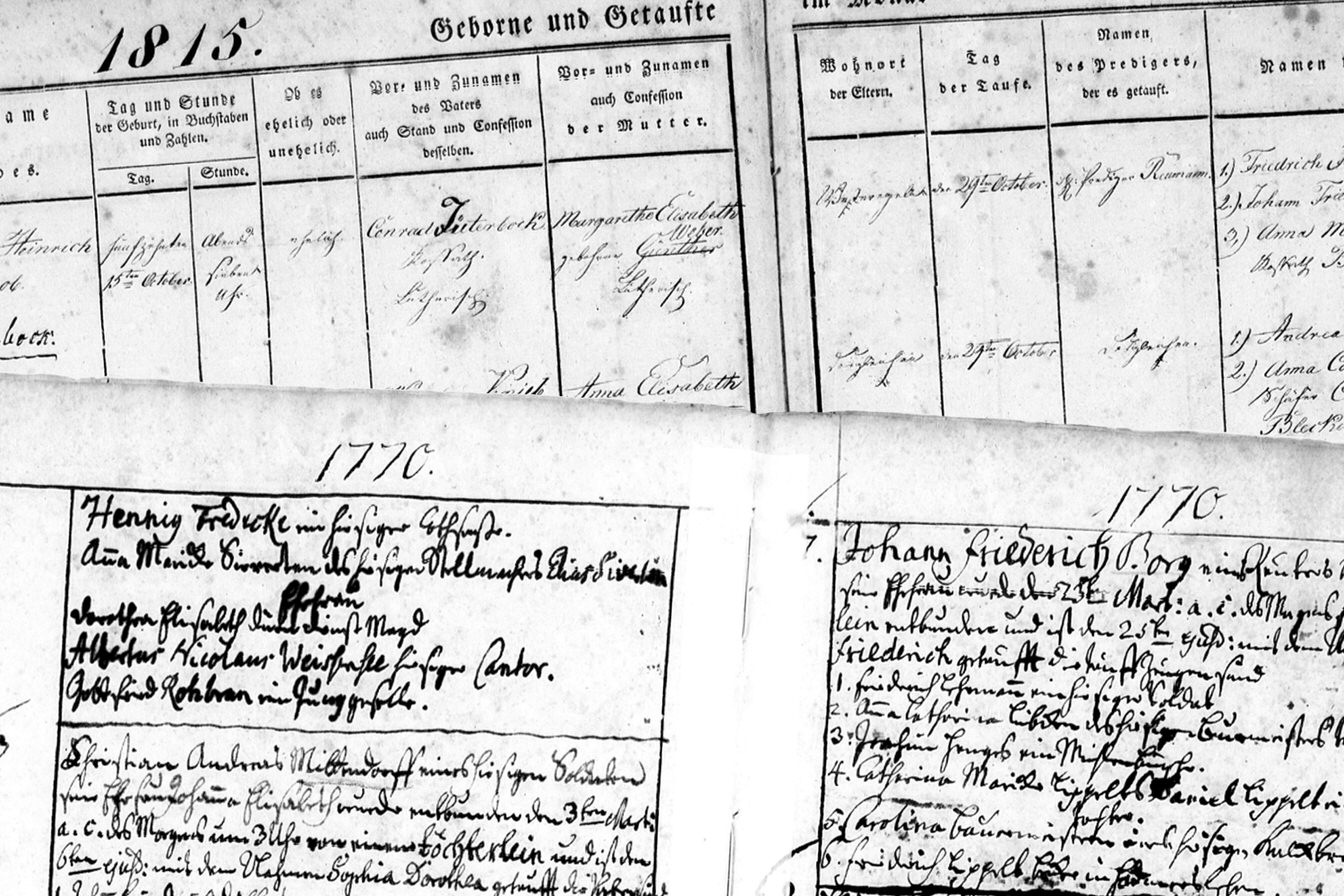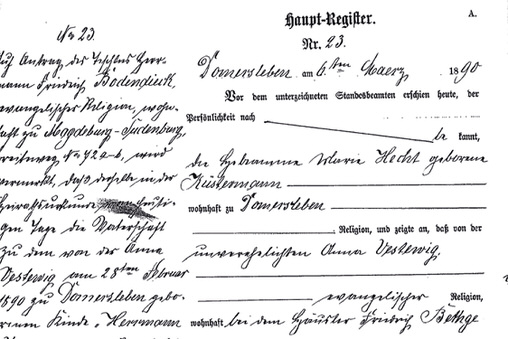How to Read Old German Church Records
Published by Gunar Bodendiek. Last updated on October 14, 2025.

German church records are among the most valuable resources for tracing your family history. Long before civil registration began in 1876, churches were responsible for recording births, baptisms, marriages, and burials. These entries can reveal generations of family connections — but reading them isn’t always easy. In this guide, you’ll learn what types of church records exist, how they’re structured, and how to interpret their archaic handwriting and terminology.
1. Types of German Church Records
Most German parishes kept several distinct registers. The main types include:
- Baptismal Registers (Taufregister): Record baptisms and often include the date of birth, baptism date, names of parents, the father’s occupation, residence, and names of godparents (Paten).
- Marriage Registers (Eheregister or Copulationsregister): Record marriages, banns (public announcements), names of bride and groom, their status (single, widowed), occupations, places of residence, and fathers’ names.
- Death or Burial Registers (Sterberegister or Begräbnisregister): Record the date of death, burial date, age at death, cause of death (sometimes), and surviving relatives.
- Confirmation Registers (Konfirmationsregister): List adolescents being confirmed into the church, usually between ages 13–15. These can help bridge generational gaps.
- Communicant or Membership Lists (Kommunikantenlisten, Seelenregister): Some parishes recorded those who received communion or were members of the congregation — often used to track local families.
2. Anatomy of a Typical Church Book Entry
While every parish had its own style, most records follow a consistent structure. Understanding these common elements will make it easier to identify key information even when the language or handwriting is difficult.
19th Century (1800s)
Entries from this period are typically written in paragraph form or simple columns. For example, a baptism entry might read:
Am 15ten März 1848 wurde geboren und am 17ten März getauft: Johann Friedrich Müller, Sohn des Maurers Heinrich Müller und seiner Ehefrau Anna geborene Schmidt, Taufzeugen: Wilhelm Bauer und Maria Schulz.
Translated: On March 15, 1848 was born and on March 17 baptized: Johann Friedrich Müller, son of mason Heinrich Müller and his wife Anna, née Schmidt. Godparents: Wilhelm Bauer and Maria Schulz.
18th Century (1700s)
Records often appear more abbreviated and with Latin or archaic German phrases. You might see a mixture like:
den 12ten Aprilis 1753: Baptizatus est Joannes Georgius, filius legitimus Michaelis Klein et uxoris Catharinae nata Müller.
Translation: On April 12, 1753 was baptized Johann Georg, legitimate son of Michael Klein and wife Catharina née Müller. Note the Latin word order and phrasing, which were common in older church books.
17th Century (1600s)
Entries can be even shorter and less standardized. Spelling varied widely, and handwriting (often in Kurrent script) can be challenging. For example:
den 4ten Junij ist begraben worden Anna, des Bauers Hans Schmidts eheliche Haußfrau.
Translation: On June 4 was buried Anna, lawful wife of farmer Hans Schmidt.
Earlier books were often written on handmade paper with ink that faded over time. Margins may contain later notes (such as “nach Amerika ausgewandert” – emigrated to America), which can be invaluable clues.
3. Common Challenges When Reading Church Records
- Old Handwriting: Most were written in Kurrent or Sütterlin script, which can look very different from modern typefaces. Letters like “e,” “n,” and “u” are especially tricky to distinguish.
- Language Mix: Some entries mix German and Latin — especially for names, months, and religious phrases.
- Abbreviations: Common words such as “geb.” (geborene = née), “ev.” (evangelisch = Protestant), and “u.” (und = and) appear frequently.
- Inconsistent Spelling: The same surname might appear in several spellings, even within one book (e.g., “Müller,” “Miller,” “Mueller”).
- Ink and Paper Deterioration: Older records may be smudged, faded, or damaged by water or insects.
4. Common Terms and Their Meanings
Here’s a list of frequently encountered words and abbreviations in German church records:
| German Term | English Translation |
|---|---|
| Geburt / geboren | Birth / born |
| Taufe / getauft | Baptism / baptized |
| Heirat / copuliert / Ehe | Marriage / married |
| Tod / gestorben | Death / died |
| begraben | Buried |
| Vater / Mutter | Father / Mother |
| Sohn / Tochter | Son / Daughter |
| ledig | Single (unmarried) |
| Witwe / Witwer | Widow / Widower |
| ehelich / unehelich | Legitimate / illegitimate |
| Pate / Pathin | Godfather / Godmother |
| Hausvater / Hausfrau | Head of household / wife |
| geb. (geborene) | née (maiden name) |
| Beruf / Stand | Occupation / status |
| Wohnort | Residence |
| Kirchspiel / Pfarrei | Parish |
5. Making the Most of Your Findings
Always transcribe and translate records carefully. Record every date, name, and place exactly as written, even if the spelling looks odd. Once you’ve deciphered a few entries, you’ll start recognizing familiar patterns and family names. Cross-referencing baptisms, marriages, and burials can help reconstruct entire family lines within one parish.
Need Help Reading Old Handwriting?
Old church records are treasures — but deciphering them takes patience and experience. At My German Origin, I specialize in reading and interpreting historical German handwriting from the 17th to 19th centuries. I can transcribe, translate, and analyze your documents to uncover the full story behind the names.
Request a free feasibility check and get professional help with your German records.



